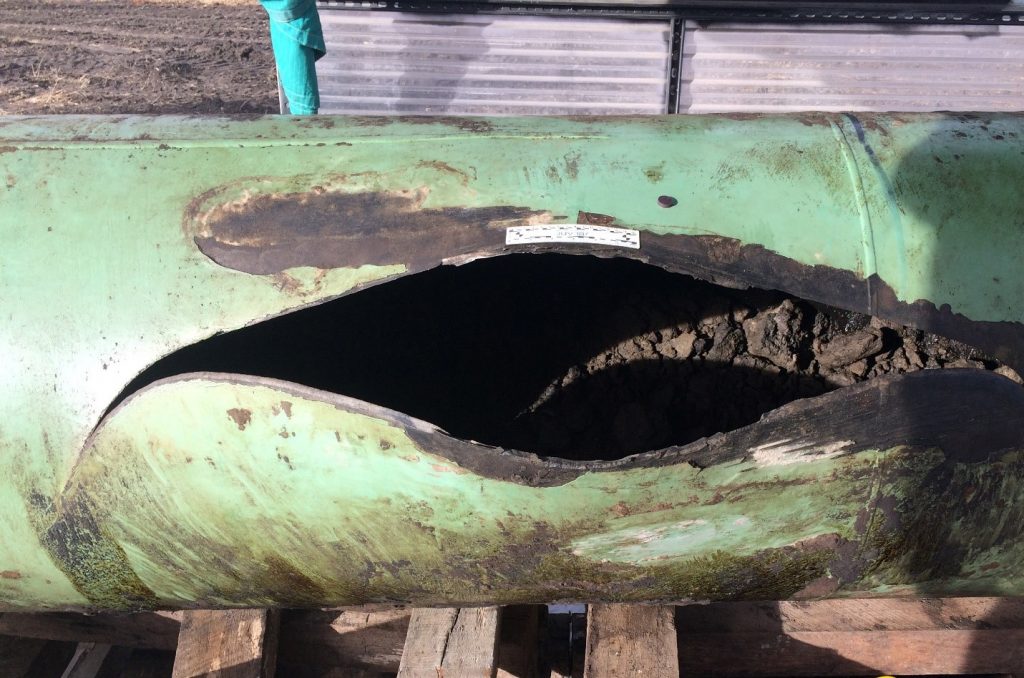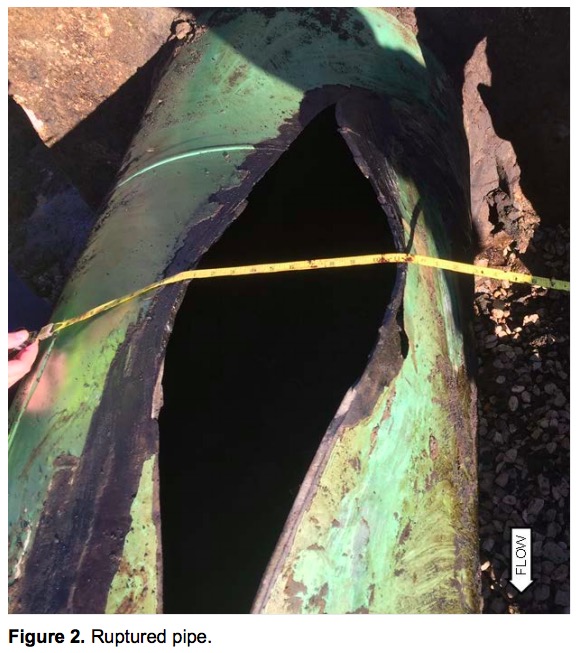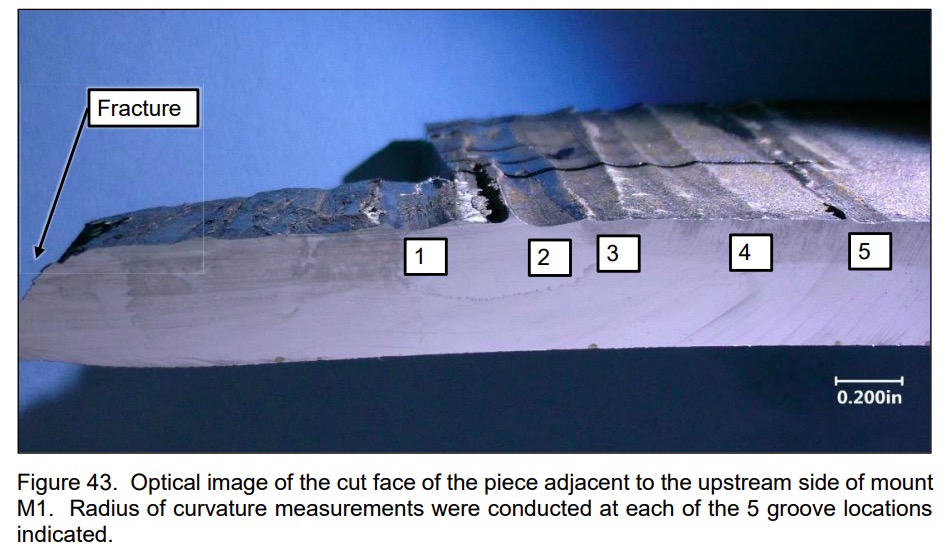How’d all that oil get on the ground?



According to a Pipeline Accident Brief released by the NTSB Thursday, the Keystone pipeline in Marshall County ruptured due to damage done to the section of pipe during construction. However, metallurgical analysis shows the culprit was not a concrete saddle dropped on the pipe to keep it floating in sandy soil. The report dismisses that early hypothesis in favor of the conclusion that someone drove a heavy caterpillar-track vehicle over the pipe during construction in 2008, leaving a stress fracture that finally blew out last fall.
The metallurgical analysis found grooves in the surface of the pipe running parallel to the axis and the rupture:

Compositional analysis of the grooved surfaces and of cross-sections through the grooves near the fatigue crack origin area revealed that smeared metal in the trough of the sliding contact-grooves contained higher concentrations of chromium than the pipe material (as determined by energy dispersive spectroscopy and backscattered electron microscopy). This was consistent with the presence of a deposited layer.
The composition of the deposited metal in the grooves, and the morphology of the groove colonies is consistent with damage that would result from the pipe being run over by a metal-tracked construction vehicle. The composition of the concrete weights was examined and ruled out as a source of the mechanical damage to the pipe [NTSB, Pipeline Accident Brief, 2018.07.05, p. 4].
Austenitic manganese steel, sometimes alloyed with chromium, is extensively used in earth-moving equipment.
The ruptured pipe was not the cheap Indian steel that makes up 47% of the Keystone pipeline. It came from Berg Steel Pipe Corporation in Florida.
The rupture itself occurred while TransCanada was cleaning and inspecting the pipe with devices—a cleaning “pig” and a leak-detecting SmartBall—traveling inside the pipeline. Getting those devices around pumping stations requires a bypass operation, which appears to back up the oil (oil can’t move as fast through the bypass as it can through the regular route through the pumping station) and increase pressure upstream. During the bypass at the Ferney station, downstream from Amherst, pressure at the Ludden station, upstream from Amherst, increased from 1,170 pounds per square inch gage to 1,352 pounds per square inch gage. Maximum permitted pressure on the Keystone pipeline is 1,440 pounds per square inch, 80% of the steel’s specified minimum yield strength, but this change in pressure was apparently enough to finally rupture the stress fracture.
Let’s be clear: according to NTSB’s analysis, the damage to the Keystone pipeline did not come from some farmer or county worker driving his Caterpillar over the pipeline after it was installed and buried. Metal track made direct contact with the metal pipe, during construction. Someone didn’t just drive over the pipe; someone drove on the pipe, left marks, and thought, “Sure, we can still put that in the ground.”
*While TransCanada told Shannon Marvel in April that the amount of oil lost was 9,700 barrels, nearly twice the original estimate, the NTSB report continues state the pipeline spilled 5,000 barrels.
Would make more sense if they blamed HRC’s emails on the spill. Nah, I guess not. Wingnuts can’t get over her emails, there is no way a bulldozer could.
Did anyone bother to recalculate the odds of a major spill happening once in 33 years or whatever Trash-Can came up with?
Good one, Mike. ” … no way a bulldozer could get over Hillary’s e-mails.” :0)
Caterpillars don’t drive on 36″ oil pipelines, mentally ill protester/water protectors do! Betcha 2026 Keystone’s Russian owner WON’T be doin’ another inspection/cleaning of this or any other over-regulated pipeline. Mike Rounds will get rid of exposing CEOs to liability with any such transparency.
Leslie, them there ‘Cat’ track tracks look suspiciously like prints left by waffle stompers or sockless Clark’s Desert Boots.
So somebody drove over the pipe with heavy machinery, and then it still lasted for 9 years? Wow. Shows you the value of using better steel.
Putting in better material to begin with, and implementing a sound testing regimen, ultimately saves money in maintenance and extends the time necessary for a complete replacement.
Ultimately infrastructure does need to be replaced. But people would rather spend money on other things. Short-term thinking ultimately costs more money in the long run.
Bigger question is whether that section of pipe had been assayed before, and what did that data look like? Were they just looking for leaks visually? Or were they using something like X-rays or ultrasonics to try and pick up discontinuities (cracks) or stresses?
Someone didn’t just drive over the pipe; someone drove on the pipe, left marks, and thought, “Sure, we can still put that in the ground.”
More likely they put the pipe in the ground and the dozer covering it drove on it. If that happened once it probably happened many times.
Ror is accurate, as usual. When I was a roughneck on oil rigs we used thousands of sections of pipe that got delivered from the hard bander or from the Exeter yard by drivers that were often negligent. The pipe sometimes got dumped on the ground with no supports under it. A piece that got buried would eventually be found and used. We didn’t leave our pipe in the ground but it’s feasible that the pipeline installers could have.
As Doc McTaggart notes, who and how was it inspected it before it was buried?
But people would rather spend money on other things. Short-term thinking ultimately costs more money in the long run.
Feckless leader said new pipelines would be built with American steel, until it was time to build and then cheaper foreign steel was okay.
Take your pick- https://www.google.com/search?q=+trump+on+using+american+steel+for+new+pipelines&ie=utf-8&oe=utf-8&client=firefox-b-1-ab
Mike, you win the internets today with comment #1!
😂😂😂😂😂😂😂😂
That is a very complex scientific conclusion the report may not have addressed. Me thinks you speak w/o substance Doc, w/all due respect. Short term thinking would be reversing the magority pivot from fossil fuel to addressing climate change big time. don’t get me going Doc. We been replacing roads bridges other transportation infrastructure for decades…oh, I guess not. instead we pASS MASSIVE 1% BENIFITIVE TAX CUTS and then rob from infrastructure, health care and every other social need instead. the ole’ guns/oil vs. butter republican scam. why do you think the GOP has designed a Koch INSPIRED master plan that milks us for the 1%’s benefit? they are preparing for revolution. Thune, Rounds and Noem will be safe.
I’d still like to know if Trasn-Can paid the 9 cents per barrel clean up tax on this oil they claimed was not tar sands but was sent to a landfill that processes hazardous waste, when the earlier spill was sent to a landfill in Minn that doesn’t supposedly handle hazardous waste.
So far, Doc happens to be right on the money. I’d go just a small amount further with:
Jesus Effing Christ this SUCKS! It sucks just even having to worry about this crap ever happening to start with! We should FORCE oil companies to use incredibly thick badass pipes so that none of this CRAP is an issue EVER again. Why not ?!?!
Double the pipe quality, use fool proof placement, for more permanent infrastructural investment returns, rather than treating the both the pipelines and the environment as disposable, and then I might be more in favor of pipelines.
I noticed when the pipeline was being built through NW iowa there was very little opportunity for cats to access the pipes, The trench was dug mostly by backhoes and wasn’t big enough for a cat to go down in to pack dirt on the pipes.
Maybe Trash-Can used the cats to push the water raised pipes back down into the ground like the concrete saddle they blamed earlier.
Yes to thicker steel.
Yes to stricter construction protocols, making sure no Caterpillar drives over pipe, not above ground, not during placement, not during backfill.
Yes to fines for any spill, and bigger fines when we find a spill came from violating safe construction protocol.
Impose all these requirements before they lay Keystone XL… and make TransCanada buy every landowner along the pipeline route a Prius.
Cory, I am not yet 100% sure, but I believe the pros outweigh the cons when it comes to above vs. below ground pipelines.
Above-ground pipelines allow for continuous adjustments to geological movement, and they allow for easier leak detection (via visual precision) as well as easier access to repair of malfunctioning segment(s).
I am AGAINST underground pipelines. If we want transcontinental pipelines transporting toxic stuff, the only safest way to do is above ground, right smack in our visual realm. Unfortunately, it costs more, in many ways, to do it the safest way we know how.
1440PSI !!!!!!!!!!!!!!! High pressure steam on navy ships is only 1/3 of that and a leak will cut a 2X4 in half. Tractor hydraulics are even less and if you have your hand in place when a line ruptures it will cut your hand off.
In stead of thicker steel maybe we shouldn’t allow such pressures. When this pipe line was being proposed it was a fraction of the size and much higher pressure than was required farther south where they have more experience with oil pipe lines.
But, if you are a friend to big oil…….
Lucky that piece of pipe didn’t get used where they went under the Missouri river!!!
Clyde, tarsands has to be heated and treated with a cocktail of various chemicals and pressurized to make it flow- hence the high pressure. thicker was constructed pipes.
Trash-Can claims the Freeman spill was ordinary Alberta crude which flows under less pressure but sure as heck can spill and damage the environment.
You think the government in tight lipped about info, just try to get oil industry to divulge the chemicals in tar sand slurry or fracking cocktails. No way.Jose. Those are fiercely protected trade secrets even doctors aren’t privy to if they have to treat people for poisoning from fracked water supplies.
Mike, I was aware that the oil is heated and juiced. How else would you get TAR sands TAR to flow. I’ve always wondered how the farmer that is stuck with a heated pipe under his corn is going to be able to grow as much as he did before it was there. It gets hot and dry in South Dakota most years. Adding heat from below I wouldn’t think would be good. Perhaps a giant green house built over the pipe for growing veggies in winter would work out. Least till a driven over pipe failed.
Maybe you found an answer to homeless shelters, at
least in the winter time. Homeless people could stay warm and grow their own foods. Give that man a Nobel.
ps I didn’t mean to sound condescending about pressurized pipes.
Yo Doc, https://www.huffingtonpost.com/entry/spiders-flying-electricity_us_5b40f8c2e4b07b827cc12bd4
What happens to renewable energy for spiders if Drumpf decides to make them carry a coal burning power plant with them as they fly? You know, just to keep coal viable.
Would small nuke reactors serve spiders better? So many ?s.
http://thehill.com/policy/energy-environment/395397-new-emails-reveal-pruitt-exempted-utah-oil-companies-from-smog
For Utah oil and gas producers it paid to have a friend in low places. Glad they got him when they did.
Are we willing to pay more for our gasoline in order to have thicker pipes and more thorough inspections? Right now the answer is unfortunately no.
A catastrophic failure has to occur, and then the higher costs associated with not doing proper inspection/maintenance and building things right the first time are passed onto us.
Essentially spiders can use static electricity to make sure those fibers they cast to drift away in the wind do not entangle with each other.
Spiders are pretty light. Coal plants are not. Small nuclear reactors would not serve spiders better…but they have more of a chance to backup renewables without emitting carbon than a coal plant or gas plant does.
Speaking of flying things, there was a group in France that recently sent in a drone shaped like Superman into a nuclear plant. They sounded disappointed that plant security didn’t shoot it down.
But since the plant can withstand airliner impacts, why bother? And why should plant security show its cards when they do not need to?
They were always going to pass on the higher costs to the consumer, it is part and parcel of their deals with wingnut devils in the government. They got to use cheaper steel to make the pipeline. Did they lower the cost of oil because of it?
No they did not and they send their lobbyists to DC to plead poverty on taxes and mean landowners and everything else so they get more favors from congress.
There is another wind farm being built in nw iowa near the town of Everly. (Clay County just off US Hiway 18) 73 more turbines are under construction and should be up and running before too long. Pretty soon nw iowa will have to stake the ground down to keep us from flying away.
How much of that wind energy is being used in Iowa for commercial/industrial/residential use, instead of being sent elsewhere?
https://www.eia.gov/state/?sid=IA#tabs-4
It looks like Iowa consumed 187.2 trillion BTUs of other renewables (not hydro, not biofuel), and produced 215.8 trillion BTUs of other renewables in 2016. That’s as close an apples to apples comparison as I can make.
In South Dakota the same plots are 36.2 Trillion BTU consumed in the state for other renewables, and 82.7 Trillion BTU produced (in 2016). So we must be sending more out of state.
its mainstem Missouri hydropower
There are Black Hills Power vehicles running all over nw iowa. Did the Black Hills get disgusted with really corrupt wingnuts and move to iowa?
Doc, I have no idea how much of the windpower is consumed in iowa but the one company alone plans to generate 10000kw by the end of 2020. Enough to power x number of homes in x number of iowas.
You have to be really careful with those numbers. Is it max capacity, or are they actually generating that amount?
And yes, the total may cover X number of households, but if it is produced when people are not using electricity…it goes elsewhere…maybe for industry…but probably out East.
Doc, if this doesn’t get you motivated to come to iowa for ideas nothing will. http://www.windsystemsmag.com/article/detail/249/new-energy-in-northwest-iowa
Imagine if iowa farmers could manage to confine wind turbines like hogs- without the odors and waste problems.
Yes, use the wind energy there for local economic development when it occurs instead of shipping it off somewhere.
But when they say 45,000 homes, they really mean the equivalent power that 45,000 homes would consume. Not that wind provides 100% of the power that those homes consume.
The wind turbines don’t start turning when you turn on the TV. But the utilities burn gas so that you can do that whenever you want.
South Dakota is clearly more ecologically sophisticated than Iowa, based on the facts of the energy created here. South Dakota powers Minneapolis, and Iowa, using our green juices.
I wouldn’t say that we are more sophisticated, just that our energy mixes are different. We make a lot of hydropower. For now Iowa has some nuclear and more wind.
But if the nuclear goes, that is when gas prices will spike. I think the Iowa plant may be a good candidate to try running in a flexible manner. If Trump pushes through the intent to use more nuclear and coal, it would behoove us to operate them both better with renewables. Iowa is going to generate more wind, not less.
Iowa generates wind? I thought the prevailing winds coming from the NW was because Iowa sucked, and ND blew.
Where Grudz comes from the wind is most likely because Dick Cheney blows.
Doc, drive down US Hiway 75 from Le Mars southward and you will see car after car of coal sitting on RR sidings. IPS plant at Port Neal South of Sux City burns alot of coal to generate electricity.
iowa isn’t just for blowhards like Grudzilla.